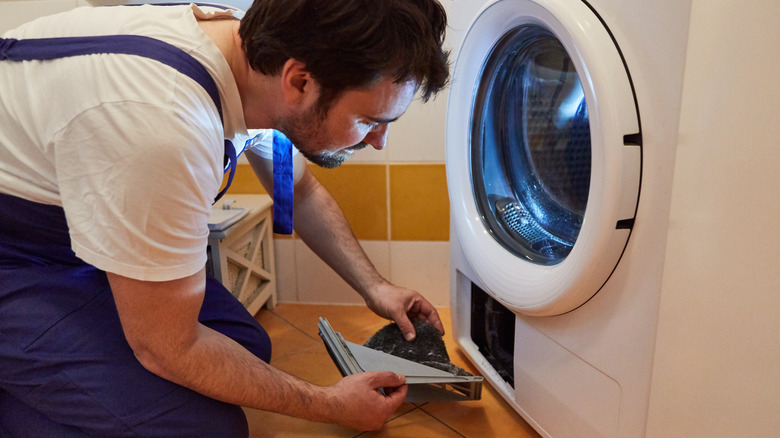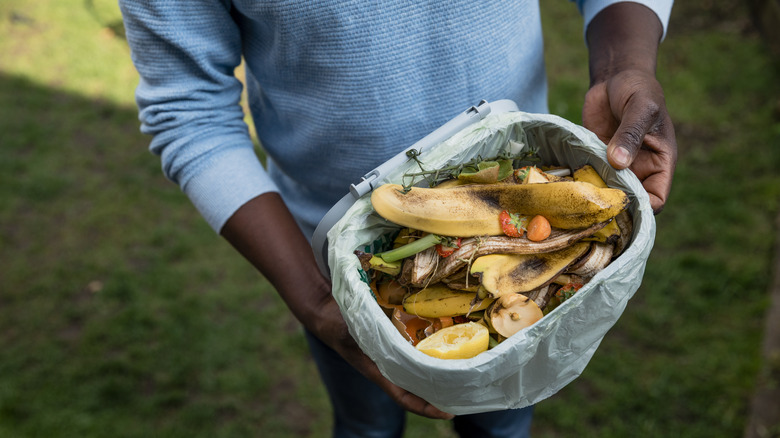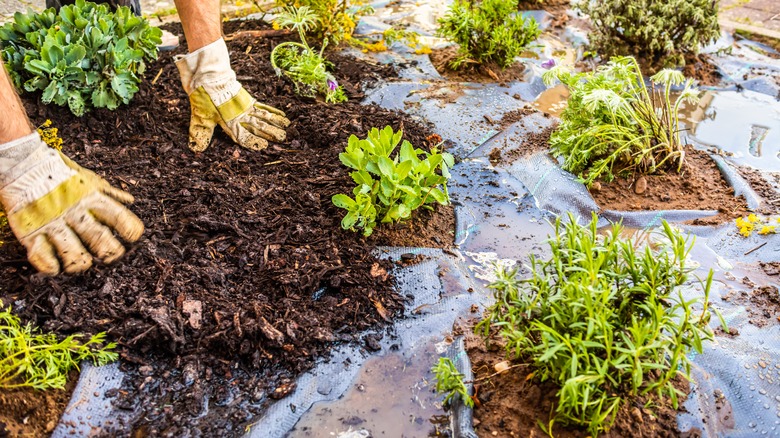Clever Ways To Reuse Dryer Lint Around The Home
Whether you're trying to live a more zero-waste lifestyle or you simply want to keep your dryer in top form, look no further than the lint in your dryer vent! In addition to being a simple cost savings hack, it can protect your home from a dangerous, devastating appliance fire. Data from the U.S. Consumer Product Safety Commission estimates more than 15,000 fires in the U.S. are caused every year by dryers, resulting in approximately $84 million worth of property damage. The culprit? Highly flammable lint that is constantly building up in the filter. Experts strongly urge laundry doers to clean out the lint trap after every single load, and to deep clean the dryer vent twice per year.
Most people are quick to toss their lint into the trash without batting an eye. However, this fuzzy byproduct has tons of clever uses around the home, so you may want to consider saving your dryer lint. We'll take you through some of our favorite hacks and show you why you'll never want to drop your laundry fluff in the garbage again. It's important to note that some of these tricks require lint that is free of fabric softeners, dryer sheets, or other additives to avoid dangerous repercussions, but we'll call this out each time.
Use it as a fire starter
Lint may look like a whole lot of fuzzy nothing, but it's highly flammable. This is due to its texture and shape allowing for easy airflow (and fire loves oxygen). Adding heat to the mix leads to combustion. You can use this to your advantage, rather than detriment, and create fire starters to have on hand for your home fireplace or camping season. The effectiveness of this hack is backed by simple science, supported by the National Park Service, and anecdotally via numerous wilderness survival enthusiasts.
To make your own dryer lint fire starters, you'll need the following supplies: a pile of lint, toilet paper tube, some petroleum jelly, and wax paper. You can cut each toilet paper tube in half to make more starters if you need a lot. To begin, fill the toilet paper tube with lint. Ensure that it's loose, because if it's too tightly compacted, it won't burn well. Next, spread a gob of petroleum jelly across the lint sticking out from each end of the tube. The petroleum jelly serves as an accelerant and will give your tubes an extra boost in the fire. Finally, cut a piece of wax paper to size and roll up your tube, twisting the ends to keep everything contained. Store the fire starters somewhere dry and safe (i.e., away from a heat source) until time to use.
Add it to your compost
Compost is a true gift to your garden, and a recycling win for the environment. It improves plant health, provides valuable nutrients, conserves water, cuts down on waste, and so much more. If you're always on the lookout for carbon-rich brown materials to add to your compost, start in the laundry room! While it isn't a powerhouse of nutrients like other compostable items, lint is beneficial because it does provide necessary carbon and fiber to your mix. Here's the caveat — you must only use lint that came tumbled from laundry without a dryer sheet. You don't want those chemicals in your compost.
If you're collecting lint for other household uses that aren't impacted by dryer sheets, set aside a separate container or bag to collect the compost-specific fluff. Once you've accumulated a good amount, it's ready to go in your bin. The process is quick and easy. Working by the handful, spread the lint evenly across the top of your compost pile. Spray this layer with your hose (just be careful not to saturate), and then gently mix with a shovel or rake.
Make a draft stopper
Does your house have older doors and windows that seem to lag behind on energy efficiency? A telltale sign is always feeling the chill of cold air whenever you pass by or noticing a significant temperature difference from one room to the next. While installing new windows and doors can be an enormous expense, ignoring the problem can lead to sky-high electric bills. The U.S. Department of Energy estimates that reducing drafts in the home can net 5 to 30% in energy savings each year. Good news — we have an easy, affordable DIY solution to warm up your home. Lint can be used to make draft stoppers to place along any doors or windows where you feel a chill.
The only supplies needed are tube socks (knee-high styles work great, too) and a large quantity of lint. Simply fill the sock with lint (ensuring that you pack it in firmly), tie off the end of the sock, and place it at your door or window. Lint is the key to a warmer home this winter! This version is much more affordable than purchasing a draft stopper at the store, though there are a couple of downsides that balance out the affordability. You'll need a lot of lint, especially if you need stoppers in multiple areas, and the lack of weight means you may have to reposition it frequently.
Make bedding for small pets
Having a pet brings incredible joy, laughter, and comfort to our lives, but the expenses associated with owning them can add up quickly. If you have cage-dwelling rodents like hamsters or guinea pigs, replacing their bedding is a daily chore, but you can save money on the cost by incorporating lint into your routine. It's soft, cozy for them to burrow into, readily available, and a completely free byproduct of your dryer. However, you must follow these guidelines to make sure it's safe for your pet. First, use a natural/unscented detergent, do not add any fabric softeners, scent beads, etc., and don't use dryer sheets. These chemicals can irritate their delicate skin and paws.
Whenever you're ready to introduce lint bedding to your pet's cage, mix it in with the current, standard material that they are used to, whether it's pine shavings, paper, or hay. See how your pet reacts, and if it's positive, then you can add more the next time you clean the cage. Because rodents love to burrow in soft material, this hack should score major points with them.
Line your garden pots
If you feel like a house isn't a home unless it's filled with plants, this hack is for you! Whether you're a master gardener or total novice, you may be surprised to know that lint can be helpful for your potted plants. While drainage holes are a necessity, they don't always function perfectly. Sometimes, too much soil seeps out the hole or water can run through too quickly (though that's usually an indication of a soil quality problem and not the fault of the pot). A liner made from dryer lint can remedy both of these issues. Expert-approved, eco-friendly, and easy on your wallet, it's a trick you'll want to try the next time you're potting or repotting your favorite plants.
The size of your pot will dictate how much lint you need to cover the bottom adequately. Once you have the appropriate amount, simply pack the lint into your pot to line it. Make sure to bring it up the sides a bit and not just press it flat across the bottom. Add your soil, the plant or flowers, water, and voilà! This hack also offers a bonus benefit. During colder months, even if your plants are indoors, the lint acts as insulation, thus protecting the delicate roots and keeping them warm.
Prevent weeds
Few things will take the pep out of a gardener's step the way weeds can. No matter how much time you spend pulling out each scraggly root or applying treatments, they always seem to weasel their way back into your flower or veggie garden. If you want to spend less time weeding so that you can actually enjoy your garden, look no further than your dryer for assistance! A thin layer of lint acts as an effective line of defense against all sorts of common weeds, especially when paired with other methods like mulch, landscaping fabric, or cardboard.
Before you lay down the lint, begin by manually removing any existing weeds in the area. Next, spread an even layer across the cleared soil or, if you have established plants, position it around their bases. To give a tidier appearance and protect from rainwater washing it away, add a layer of mulch on top. Lint is a biodegradable material, so you don't need to worry about it harming your dirt. However, to be on the safe side, any lint used in the garden should be free from additives like fabric softener or dryer sheets.
Cushion your belongings
Whether you're moving into your first home or you're a seasoned pro who has lived in numerous places, the move itself can be stressful, time-consuming, and costly. From hiring movers to buying boxes and packing material, money's flying out of your wallet left and right. We'll let you in on a little secret to remember next time you house hop: There's a clever way to repurpose dryer lint to save money during a move! The soft, cushioning material is perfect for wrapping glassware, mugs, candles, or anything else that's fragile and relatively small. We add the caveat about size because this hack is not recommended for large, highly breakable items like mirrors. Lint can't quite provide that level of protection, but it's terrific for handheld items.
For this hack, you'll simply need a large quantity of lint. However, if you're packaging anything with a high sentimental (or monetary) value, you may want to consider using the lint in tandem with another material, such as newspaper or bubble wrap, to ensure complete protection. Use the lint as the innermost wrapping, since its softness simply can't be beat. Plus, you won't have to worry about it scratching any delicate glassware.







